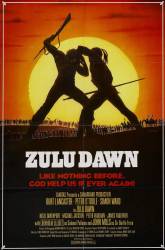Corrected entry: British non-commissioned officers are never addressed as "Sir."
Corrected entry: Whoever did the costumes had no idea of British Army officer badges of rank. Junior officers, LTs, display a crown, the badge of a major. Lt. Col. Pulliene shows 1 'pip', the rank of 2nd Lieutenant. Chelmsford has sword crossed with scabbard plus two pips - no such rank: a Lt. Gen. has sword/scabbard plus a crown. Lt. Col. Durnford is correct: pip surmounted by a crown. But Durnford I think, was actually a full colonel: 2 pips in line surmounted by a crown.
Correction: From 1855 to 1880 British Army rank insignia was somewhat different to what it is now; worn on the collar; ranks were distinguished as follows: a Second Lieutenant wore a single "pip", as now; a Lieutenant wore a single crown, and a Captain wore a pip and a crown. Majors then, also wore a single pip; Lieutenant Colonels, the crown, and full Colonels, a pip and crown. The problem of course is that now we have two ranks wearing identical rank insignia; the distinction then lay in the gold lace worn around the collar and on the cuffs. Junior officers (Subalterns, Lieutenants and Captains had a single row of half-inch gold lace; Majors, Lieutenant Colonels and Colonels had two rows). Suffice to say it was a confusing system (and not helped by the fact that the dark blue patrol jackets often worn in the field had no gold lace whatsoever), and it is probably because of this that in 1880, the year after Isandlwana, the system the British Army still uses to this day was introduced.
Corrected entry: In the movie a lot is made of the unwillingness of the Quartermaster to issue ammunition and of the difficulty in opening the ammunition boxes. In fact the boxes could easily be kicked open or smashed open with a rifle butt and shortage of ammunition was not a major factor in the defeat. The Martini Henri rifles had a tendency to overheat and jam and this was much more problematic to the British. After the battle, many unworkable rifles were found abandoned.
Correction: There is so much wrong with this "correction." For starters, the rifles taken at Isandlwana by the Zulus were not used at Rorke's Drift. Stop getting your history from movies. Also, you cannot day that ammunition was "the problem" at Isandlwana. You are taking the words of cowards who fled their posts in mid battle and used that as an excuse to justify their flight.
Correction: Ammunition distribution was indeed the problem at the Battle of Isandhlwana. The Quartermaster refused to even show the messengers asking for ammunition the crates, and you can't knock a crate open with a rifle butt when you don't have it. Also consider that the average British soldier at Rorke's Drift fired 260 out of his Martini-Henry Mk. II. Lieutenant Chard's battle report did not include anything at all about Martini-Henrys jamming. While unworkable rifles were found after the battle, they were in the vast minority. The Zulus captured almost all of the rifles at Isandhlwana and they were hardly unworkable at the subsequent battle at Rorke's Drift. The Quartermaster was also afraid to distribute ammunition because he worried about being reprimanded about recklessly handing out ammunition.
Correction: 500 characters isn't nearly enough to correct this myth. Cpt. Essex organized an ammunition resupply with QM Bloomfield who was killed early on by a stray round. Lt. Smith-Dorrien got into a disagreement with Bloomfield regarding ammunition earlier in the engagement, but this was quickly resolved as in a letter home SD mentioned that he was distributing ammo at the when the line collapsed. Archaeology, British and Zulu accounts all indicate sufficient ammo to the 24th at least.






Correction: A Warrant Officer is not a Senior Non-Commissioned Officer (SNCO) as he/she holds the Queen's Warrant and is therefore always addressed as Sir/Ma'am by subordinate ranks.